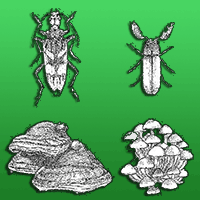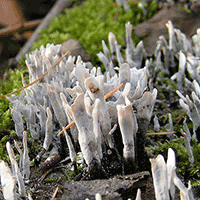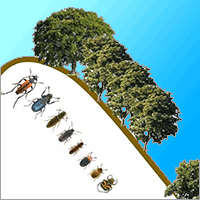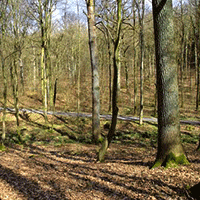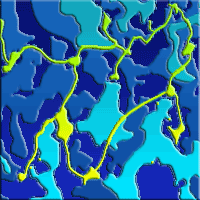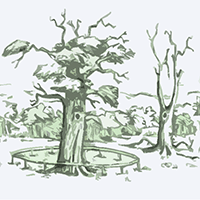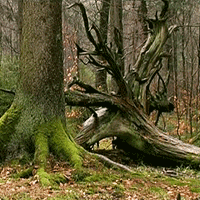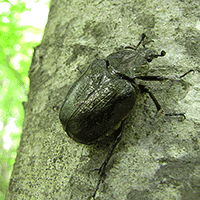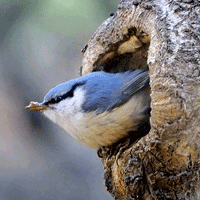Deadwood is a substantial component of forests playing a central role in many ecosystem processes. It provides habitats for a multitude of wood-dependent organisms, maintaining the ecosystem health and reducing the effect of natural disturbances. Deadwood is recognized as an indicator of local species diversity and contributes to the global carbon pools and nutrient cycles. Despite its importance, how saproxylic communities respond to deadwood dynamics across multiple spatial and temporal scales is still not clear. With the present review, we aim to summarize the effects of deadwood characteristics on the diversity and composition of saproxylic insects and fungi, with focus on European forests. We also discuss the influence of other biotic and abiotic components that indirectly affect these communities by altering wood continuity and variety. Niche differentiation is the main ecological driver of saproxylic organisms, as the presence of multiple microhabitats supports differently specialized taxa. The assemblage and richness of these saproxylic communities within forest ecosystems can be considered as indicators of climate-smart forestry trajectories. This aspect deserves to be regarded as a major target in sustainable forest management plans, especially in mountain areas, where the conservation of threatened species and the promotion of biodiverse forests are considered a priority.
Keywords
, , , , ,
Citation
Parisi F, Pioli S, Lombardi F, Fravolini G, Marchetti M, Tognetti R (2018). Linking deadwood traits with saproxylic invertebrates and fungi in European forests - a review. iForest 11: 423-436. - doi: 10.3832/ifor2670-011
Academic Editor
Massimo Faccoli
Paper history
Received: Oct 27, 2017
Accepted: Apr 14, 2018
First online: Jun 18, 2018
Publication Date: Jun 30, 2018
Publication Time: 2.17 months
© SISEF - The Italian Society of Silviculture and Forest Ecology 2018
Open Access
This article is distributed under the terms of the Creative Commons Attribution-Non Commercial 4.0 International (https://creativecommons.org/licenses/by-nc/4.0/), which permits unrestricted use, distribution, and reproduction in any medium, provided you give appropriate credit to the original author(s) and the source, provide a link to the Creative Commons license, and indicate if changes were made.

Breakdown by View Type
(Waiting for server response...)
Article Usage
Total Article Views: 59424
(from publication date up to now)
Breakdown by View Type
HTML Page Views: 47386
Abstract Page Views: 5503
PDF Downloads: 5515
Citation/Reference Downloads: 40
XML Downloads: 980
Web Metrics
Days since publication: 2740
Overall contacts: 59424
Avg. contacts per week: 151.81
Article Citations
Article citations are based on data periodically collected from the Clarivate Web of Science web site
(last update: Mar 2025)
Total number of cites (since 2018): 74
Average cites per year: 9.25
Publication Metrics
by Dimensions ©
Articles citing this article
List of the papers citing this article based on CrossRef Cited-by.
(1)
Abrego N, Salcedo I (2013)Variety of woody debris as the factor influencing wood-inhabiting fungal richness and assemblages: is it a question of quantity or quality? Forest Ecology and Management 291: 377-385.
CrossRef |
Gscholar
(2)
Baldrian P (2008)Enzymes of saprotrophic basidiomycetes. In: “British Mycological Society Symposia Series” (Boddy L, Frankland J, VanWest P eds). Academic Press, New York, pp. 19-41.
CrossRef |
Gscholar
(3)
Bani A, Pioli S, Ventura M, Panzacchi P, Borruso L, Tognetti R, Tonon G, Brusetti L (2018)The role of microbial community in the decomposition of leaf litter and deadwood. Applied Soil Ecology 126: 75-84.
CrossRef |
Gscholar
(4)
Bässler C, Müller J, Dziock F, Brandl R (2010)Effects of resource availability and climate on the diversity of wood-decaying fungi. Journal of Ecology 98: 822-832.
CrossRef |
Gscholar
(5)
Bässler C, Müller J, Svoboda M, Lepšová A, Hahn C, Holzer H, Pouska V (2011)Diversity of wood-decaying fungi under different disturbance regimesâa case study from spruce mountain forests. Biodiversity and Conservation 21: 33-49.
CrossRef |
Gscholar
(6)
Berglund H, Jönsson MT, Penttilä R, Vanha-Majamaa I (2011)The effects of burning and dead-wood creation on the diversity of pioneer wood-inhabiting fungi in managed boreal spruce forests. Forest Ecology and Management 261: 1293-1305.
CrossRef |
Gscholar
(7)
Blaser S, Prati D, Senn-Irlet B, Fischer M (2013)Effects of forest management on the diversity of deadwood-inhabiting fungi in Central European forests. Forest Ecology and Management 304: 42-48.
CrossRef |
Gscholar
(8)
Blonska E, Kacprzyk M, Spólnik A (2017)Effect of deadwood of different tree species in various stages of decomposition on biochemical soil properties and carbon storage. Ecological Research 32: 193-203.
CrossRef |
Gscholar
(9)
Boddy L (2001)Fungal community ecology and wood decomposition processes in angiosperms: from standing tree to complete decay of coarse woody debris. Ecological Bulletins 49: 43-56.
Online |
Gscholar
(10)
Bowman DM, Murphy BP, Boer MM, Bradstock RA, Cary GJ, Cochrane MA, Fensham RJ, Krawchuk MA, Price OF, Williams RJ (2013)Forest fire management, climate change, and the risk of catastrophic carbon losses. Frontiers in Ecology and the Environment 11: 66-68.
CrossRef |
Gscholar
(11)
Brazee NJ, Lindner DL, D’Amato AW, Fraver S, Forrester JA, Mladenoff DJ (2014)Disturbance and diversity of wood-inhabiting fungi: effects of canopy gaps and downed woody debris. Biodiversity and Conservation 23: 2155-2172.
CrossRef |
Gscholar
(12)
Buse J, Ranius T, Assmann T (2008)An endangered longhorn beetle associated with old oaks and its possible role as an ecosystem engineer. Conservation Biology 22: 329-337.
CrossRef |
Gscholar
(13)
Byers J (2007)Chemical ecology of bark beetles in a complex olfactory landscape. In: “Bark and wood boring insects in living trees in Europe, a synthesis” (Lieutier F, Day KR, Battisti A, Gregoire J-C, Evans HF eds). Kluwer Academic Publishers, The Netherlands, pp. 89-134.
CrossRef |
Gscholar
(14)
Carpaneto GM, Baviera C, Biscaccianti AB, Brandmayr P, Mazzei A, Mason F, Battistoni A, Teofili C, Rondinini C, Fattorini S (2015)A red list of Italian saproxylic beetles: taxonomic overview, ecological features and conservation issues (Coleoptera). Fragmenta entomologica 47: 53-126.
CrossRef |
Gscholar
(15)
Castagneri D, Garbarino M, Berretti R, Motta R (2010)Site and stand effects on coarse woody debris in montane mixed forests of Eastern Italian Alps. Forest Ecology and Management 260: 1592-1598.
CrossRef |
Gscholar
(16)
Chauchard S, Carcaillet C, Guibal F (2007)Patterns of land-use abandonment control tree-recruitment and forest dynamics in Mediterranean mountains. Ecosystems 10: 936-948.
CrossRef |
Gscholar
(17)
Cornelissen JH, Sass-Klaassen U, Poorter L, Van Geffen K, Van Logtestijn RS, Van Hal J, Goudzwaard L, Sterck FJ, Klaassen RK, Freschet GT (2012)Controls on coarse wood decay in temperate tree species: birth of the LOGLIFE experiment. Ambio 41: 231-245.
CrossRef |
Gscholar
(18)
Dajoz R (2000)Insects and forests: the role and diversity of insects in the forest environment. Intercept Limited, Paris, France, pp. 620.
Gscholar
(19)
Densmore N, Parminter J, Stevens VT (2005)Coarse woody debris: inventory, decay modelling, and management implications in three biogeoclimatic zones. Journal of Ecosystems and Management 5: 14-29.
Online |
Gscholar
(20)
Dove NC, Keeton WS (2015)Structural Complexity Enhancement increases fungal species richness in northern hardwood forests. Fungal Ecology 13: 181-192.
CrossRef |
Gscholar
(21)
Edman M, Gustafsson M, Stenlid J, Ericson L (2004)Abundance and viability of fungal spores along a forestry gradient-responses to habitat loss and isolation? Oikos 104: 35-42.
CrossRef |
Gscholar
(22)
Ehnström B, Axelsson R (2002)Insektsgnag i bark och ved [Galleries and exit holes of insects living in bark and wood]. ArtDatabanken, SLU, Almqvist and Wiksell, Uppsala, Sweden, pp. 512. [in Swedish]
Gscholar
(23)
Farris KL, Huss MJ, Zack S (2004)The role of foraging woodpeckers in the decomposition of ponderosa pine snags. The Condor 106: 50-59.
CrossRef |
Gscholar
(24)
Fischer AL, Moncalvo J-M, Klironomos JN, Malcolm JR (2012)Fruiting body and molecular rDNA sampling of fungi in woody debris from logged and unlogged boreal forests in Northeastern Ontario. Ecoscience 19: 374-390.
CrossRef |
Gscholar
(25)
Floren A, Krüger D, Müller T, Dittrich M, Rudloff R, Hoppe B, Linsenmair KE (2015)Diversity and interactions of wood-inhabiting fungi and beetles after deadwood Enrichment. PLoS ONE 10: e0143566.
CrossRef |
Gscholar
(26)
Fridman J, Walheim M (2000)Amount, structure, and dynamics of dead wood on managed forestland in Sweden. Forest Ecology and Management 131: 23-36.
CrossRef |
Gscholar
(27)
Fukasawa Y, Matsuoka S (2015)Communities of wood-inhabiting fungi in dead pine logs along a geographical gradient in Japan. Fungal Ecology 18: 75-82.
CrossRef |
Gscholar
(28)
Fukasawa Y, Osono T, Takeda H (2009)Dynamics of physicochemical properties and occurrence of fungal fruit bodies during decomposition of coarse woody debris of
Fagus crenata. Journal of Forest Research 14: 20-29.
CrossRef |
Gscholar
(29)
Garrett LG, Kimberley MO, Oliver GR, Pearce SH, Paul TS (2010)Decomposition of woody debris in managed
Pinus radiata plantations in New Zealand. Forest Ecology and Management 260: 1389-1398.
CrossRef |
Gscholar
(30)
Gonzalez-Polo M, Fernández-Souto A, Austin AT (2013)Coarse woody debris stimulates soil enzymatic activity and litter decomposition in an old-growth temperate forest of Patagonia, Argentina. Ecosystems 16: 1025-1038.
CrossRef |
Gscholar
(31)
Halme P, Odor P, Christensen M, Piltaver A, Veerkamp M, Walleyn R, Siller I, Heilmann-Clausen J (2013)The effects of habitat degradation on metacommunity structure of wood-inhabiting fungi in European beech forests. Biological Conservation 168: 24-30.
CrossRef |
Gscholar
(32)
Hanson CA, Allison SD, Bradford MA, Wallenstein MD, Treseder KK (2008)Fungal taxa target different carbon sources in forest soil. Ecosystems 11: 1157-1167.
CrossRef |
Gscholar
(33)
Harmon ME (2001)Carbon sequestration in forests: addressing the scale question. Journal of Forestry 99: 24-29.
Online |
Gscholar
(34)
Harmon ME, Franklin JF, Swanson FJ, Sollins P, Gregory S, Lattin J, Anderson N, Cline S, Aumen N, Sedell J (1986)Ecology of coarse woody debris in temperate ecosystems. Advances in Ecological Research 15: 133-302.
CrossRef |
Gscholar
(35)
Heilmann-Clausen J, Christensen M (2004)Does size matter? Forest Ecology and Management 201: 105-117.
CrossRef |
Gscholar
(36)
Hunter ML (1990)Wildlife, forests, and forestry. Principles of managing forests for biological diversity. Prentice Hall, Englewood Cliffs, NJ, USA, pp. 370.
Gscholar
(37)
Jacobs JM, Work TT (2012)Linking deadwood-associated beetles and fungi with wood decomposition rates in managed black spruce forests. Canadian Journal of Forest Research 42: 1477-1490.
CrossRef |
Gscholar
(38)
Jonsson BG, Kruys N, Ranius T (2005)Ecology of species living on dead wood - lessons for dead wood management. Silva Fennica 39: 289-309.
CrossRef |
Gscholar
(39)
Jönsson MT, Edman M, Jonsson BG (2008)Colonization and extinction patterns of wood-decaying fungi in a boreal old-growth
Picea abies forest. Journal of Ecology 96: 1065-1075.
CrossRef |
Gscholar
(40)
Jönsson MT, Jonsson BG (2007)Assessing coarse woody debris in Swedish woodland key habitats: implications for conservation and management. Forest Ecology and Management 242:363-373.
CrossRef |
Gscholar
(41)
Juutilainen K, Halme P, Kotiranta H, Mönkkönen M (2011)Size matters in studies of dead wood and wood-inhabiting fungi. Fungal Ecology 4:342-349.
CrossRef |
Gscholar
(42)
Juutilainen K, Mönkkönen M, Kotiranta H, Halme P (2014)The effects of forest management on wood-inhabiting fungi occupying dead wood of different diameter fractions. Forest Ecology and Management 313: 283-291.
CrossRef |
Gscholar
(43)
Kahl T, Arnstadt T, Baber K, Bässler C, Bauhus J, Borken W, Buscot F, Floren A, Heibl C, Hessenmöller D (2017)Wood decay rates of 13 temperate tree species in relation to wood properties, enzyme activities and organismic diversities. Forest Ecology and Management 391: 86-95.
CrossRef |
Gscholar
(44)
Kappes H, Catalano C, Topp W (2007)Coarse woody debris ameliorates chemical and biotic soil parameters of acidified broad-leaved forests. Applied Soil Ecology 36: 190-198.
CrossRef |
Gscholar
(45)
Kenis M, Wegensteiner R, Griffin C (2004a)Parasitoids, predators, nematodes and pathogens associated with bark weevil pests. In: “Bark and wood boring insects in living trees in Europe, a synthesis” (Lieutier F, Day KR, Grégoire JC, Evans HF eds). Kluwer Academic Publishers, The Netherlands, pp. 395-414.
Gscholar
(46)
Kenis M, Wermelinger B, Grégoire J-C (2004b)Research on parasitoids and predators of Scolytidae - a review. In: “Bark and Wood Boring Insects in Living Trees in Europe, a Synthesis”. Kluwer Academic Publishers, UK, pp. 237-290.
Gscholar
(47)
Küffer N, Senn-Irlet B (2005a)Diversity and ecology of wood-inhabiting aphyllophoroid basidiomycetes on fallen woody debris in various forest types in Switzerland. Mycological Progress 4: 77-86.
CrossRef |
Gscholar
(48)
Küffer N, Senn-Irlet B (2005b)Influence of forest management on the species richness and composition of wood-inhabiting basidiomycetes in Swiss forests. Biodiversity and Conservation 14: 2419-2435.
CrossRef |
Gscholar
(49)
Kurth VJ, Fransioli N, Fulé PZ, Hart SC, Gehring CA (2013)Stand-replacing wildfires alter the community structure of wood-inhabiting fungi in southwestern ponderosa pine forests of the USA. Fungal Ecology 6: 192-204.
CrossRef |
Gscholar
(50)
Lassauce A, Paillet Y, Jactel H, Bouget C (2011)Deadwood as a surrogate for forest biodiversity: meta-analysis of correlations between deadwood volume and species richness of saproxylic organisms. Ecological Indicators 11: 1027-1039.
CrossRef |
Gscholar
(51)
Lindenmayer D, Franklin J, Fischer J (2006)General management principles and a checklist of strategies to guide forest biodiversity conservation. Biological Conservation 131: 433-445.
CrossRef |
Gscholar
(52)
Lindhe A, Asenblad N, Toresson H-G (2004)Cut logs and high stumps of spruce, birch, aspen and oak - nine years of saproxylic fungi succession. Biological Conservation 119: 443-454.
CrossRef |
Gscholar
(53)
Lombardi F, Lasserre B, Tognetti R, Marchetti M (2008)Deadwood in relation to stand management and forest type in Central Apennines (Molise, Italy). Ecosystems 11: 882-894.
CrossRef |
Gscholar
(54)
Lombardi F, Lasserre B, Chirici G, Tognetti R, Marchetti M (2012)Deadwood occurrence and forest structure as indicators of old-growth forest conditions in Mediterranean mountainous ecosystems. Ecoscience 19: 344-355.
CrossRef |
Gscholar
(55)
Manson RH, Stiles EW (1998)Links between microhabitat preferences and seed predation by small mammals in old fields. Oikos 82: 37-50.
CrossRef |
Gscholar
(56)
Mountain Research Initiative - EDW Working Group (2015)Elevation-dependent warming in mountain regions of the world. Nature Climate Change 5: 424-430.
CrossRef |
Gscholar
(57)
Müller J, Bütler R (2010)A review of habitat thresholds for dead wood: a baseline for management recommendations in European forests. European Journal of Forest Research 129: 981-992.
CrossRef |
Gscholar
(58)
Nielsen UN, Ayres E, Wall DH, Bardgett RD (2011)Soil biodiversity and carbon cycling: a review and synthesis of studies examining diversity-function relationships. European Journal of Soil Science 62: 105-116.
CrossRef |
Gscholar
(59)
Niemelä T, Renvall P, Penttilä R (1995)Interactions of fungi at late stages of wood decomposition. Annales Botanici Fennici 32: 141-152.
Online |
Gscholar
(60)
Nieto A, Alexander K (2010)European red list of saproxylic beetles. Publications Office of the European Union, Luxembourg, pp. 39.
Gscholar
(61)
Odor P, Heilmann-Clausen J, Christensen M, Aude E, Van Dort K, Piltaver A, Siller I, Veerkamp M, Walleyn R, Standovár T (2006)Diversity of dead wood inhabiting fungi and bryophytes in semi-natural beech forests in Europe. Biological Conservation 131: 58-71.
CrossRef |
Gscholar
(62)
Olajuyigbe SO, Tobin B, Gardiner P, Nieuwenhuis M (2011)Stocks and decay dynamics of above-and belowground coarse woody debris in managed Sitka spruce forests in Ireland. Forest Ecology and Management 262: 1109-1118.
CrossRef |
Gscholar
(63)
Palombo C, Chirici G, Marchetti M, Tognetti R (2013)Is land abandonment affecting forest dynamics at high elevation in Mediterranean mountains more than climate change? Plant Biosystems 147: 1-11.
CrossRef |
Gscholar
(64)
Parfitt D, Hunt J, Dockrell D, Rogers HJ, Boddy L (2010)Do all trees carry the seeds of their own destruction? PCR reveals numerous wood decay fungi latently present in sapwood of a wide range of angiosperm trees. Fungal Ecology 3: 338-346.
CrossRef |
Gscholar
(65)
Parisi F, Lombardi F, Sciarretta A, Tognetti R, Campanaro A, Marchetti M, Trematerra P (2016)Spatial patterns of saproxylic beetles in a relic silver fir forest (Central Italy), relationships with forest structure and biodiversity indicators. Forest Ecology and Management 381: 217-234.
CrossRef |
Gscholar
(66)
Pasanen H, Junninen K, Kouki J (2014)Restoring dead wood in forests diversifies wood-decaying fungal assemblages but does not quickly benefit red-listed species. Forest Ecology and Management 312: 92-100.
CrossRef |
Gscholar
(67)
Persiani A, Lombardi F, Lunghini D, Granito V, Tognetti R, Maggi O, Pioli S, Marchetti M (2016)Stand structure and deadwood amount influences saproxylic fungal biodiversity in Mediterranean mountain unmanaged forests. iForest 9: 1057-1066.
CrossRef |
Gscholar
(68)
Pioli S, Antonucci S, Giovannelli A, Traversi ML, Borruso L, Bani A, Brusetti L, Tognetti R (2018)Community fingerprinting reveals increasing wood-inhabiting fungal diversity in unmanaged Mediterranean forests. Forest Ecology and Management 408: 202-210.
CrossRef |
Gscholar
(69)
Pouska V, Svoboda M, Lepšová A (2010)The diversity of wood-decaying fungi in relation to changing site conditions in an old-growth mountain spruce forest, Central Europe. European Journal of Forest Research 129: 219-231.
CrossRef |
Gscholar
(70)
Prewitt L, Kang Y, Kakumanu ML, Williams M (2014)Fungal and bacterial community succession differs for three wood types during decay in a forest soil. Microbial Ecology 68: 212-221.
CrossRef |
Gscholar
(71)
Purahong W, Hoppe B, Kahl T, Schloter M, Schulze ED, Bauhus J, Buscot F, Kruger D (2014)Changes within a single land-use category alter microbial diversity and community structure: molecular evidence from wood-inhabiting fungi in forest ecosystems. Journal of Environmental Management 139: 109-119.
CrossRef |
Gscholar
(72)
Raffa KF, Aukema BH, Bentz BJ, Carroll AL, Hicke JA, Turner MG, Romme WH (2008)Cross-scale drivers of natural disturbances prone to anthropogenic amplification: the dynamics of bark beetle eruptions. AIBS Bulletin 58: 501-517.
CrossRef |
Gscholar
(73)
Rajala T, Peltoniemi M, Hantula J, Mäkipää R, Pennanen T (2011)RNA reveals a succession of active fungi during the decay of Norway spruce logs. Fungal Ecology 4: 437-448.
CrossRef |
Gscholar
(74)
Rajala T, Peltoniemi M, Pennanen T, Makipaa R (2012)Fungal community dynamics in relation to substrate quality of decaying Norway spruce (
Picea abies [L.] Karst.) logs in boreal forests. FEMS Microbiology Ecology 81: 494-505.
CrossRef |
Gscholar
(75)
Ranius T, Jansson N (2000)The influence of forest regrowth, original canopy cover and tree size on saproxylic beetles associated with old oaks. Biological Conservation 95: 85-94.
CrossRef |
Gscholar
(76)
Ranius T, Wilander P (2000)Occurrence of
Larca lata HJ Hansen (Pseudoscorpionida: Garypidae) and
Allochernes wideri CL Koch (Pseudoscorpionida: Chernetidae) in tree hollows in relation to habitat quality and density. Journal of Insect Conservation 4: 23-31.
CrossRef |
Gscholar
(77)
Russell MB, Woodall CW, D’Amato AW, Fraver S, Bradford JB (2014)Linking climate change and downed woody debris decomposition across forests of the eastern United States. Biogeosciences 11: 6417.
Online |
Gscholar
(78)
Russell MB, Fraver S, Aakala T, Gove JH, Woodall CW, D’Amato AW, Ducey MJ (2015)Quantifying carbon stores and decomposition in dead wood: A review. Forest Ecology and Management 350: 107-128.
CrossRef |
Gscholar
(79)
Sabatini F, Burrascano S, Azzella M, Barbati A, De Paulis S, Di Santo D, Facioni L, Giuliarelli D, Lombardi F, Maggi O (2016)One taxon does not fit all: herb-layer diversity and stand structural complexity are weak predictors of biodiversity in
Fagus sylvatica forests. Ecological Indicators 69: 126-137.
CrossRef |
Gscholar
(80)
Saint-Germain M, Drapeau P, Buddle MC (2007)Host-use patterns of saproxylic phloeophagous and xylophagous Coleoptera adults and larvae along the decay gradient in standing dead black spruce and aspen. Ecography 30: 737-748.
CrossRef |
Gscholar
(81)
Sánchez-Galván IR, Quinto J, Micó E, Galante E, Marcos-García M (2014)Facilitation among saproxylic insects inhabiting tree hollows in a Mediterranean forest: the case of cetonids (Coleoptera: Cetoniidae) and syrphids (Diptera: Syrphidae). Environmental Entomology 43: 336-343.
CrossRef |
Gscholar
(82)
Scarascia-Mugnozza G, Oswald H, Piussi P, Radoglou K (2000)Forests of the Mediterranean region: gaps in knowledge and research needs. Forest Ecology and Management 132: 97-109.
CrossRef |
Gscholar
(83)
Seibold S, Bässler C, Brandl R, Gossner MM, Thorn S, Ulyshen MD, Müller J (2015)Experimental studies of dead-wood biodiversity - a review identifying global gaps in knowledge. Biological Conservation 191: 139-149.
CrossRef |
Gscholar
(84)
Seidl R, Rammer W, Spies TA (2014)Disturbance legacies increase the resilience of forest ecosystem structure, composition, and functioning. Ecological Applications 24: 2063-2077.
CrossRef |
Gscholar
(85)
Setälä H, McLean MA (2004)Decomposition rate of organic substrates in relation to the species diversity of soil saprophytic fungi. Oecologia 139: 98-107.
CrossRef |
Gscholar
(86)
Shorohova E, Kapitsa E (2014)Influence of the substrate and ecosystem attributes on the decomposition rates of coarse woody debris in European boreal forests. Forest Ecology and Management 315: 173-184.
CrossRef |
Gscholar
(87)
Siitonen J (2001)Forest management, coarse woody debris and saproxylic organisms: Fennoscandian boreal forests as an example. Ecological Bulletins 49: 11-41.
Online |
Gscholar
(88)
Spears J, Lajtha K (2004)The imprint of coarse woody debris on soil chemistry in the western Oregon Cascades. Biogeochemistry 71: 163-175.
CrossRef |
Gscholar
(89)
Speight MC (1989)Saproxylic invertebrates and their conservation. Council of Europe, Strasbourg, France, pp. 80.
Gscholar
(90)
Stokland JN, Larsson K-H (2011)Legacies from natural forest dynamics: different effects of forest management on wood-inhabiting fungi in pine and spruce forests. Forest Ecology and Management 261: 1707-1721.
CrossRef |
Gscholar
(91)
Stokland JN, Siitonen J, Jonsson BG (2012)Biodiversity in dead wood. Cambridge University Press, Cambridge, UK, pp. 524.
Gscholar
(92)
Tanahashi M, Matsushita N, Togashi K (2009)Are stag beetles fungivorous? Journal of Insect Physiology 55: 983-988.
CrossRef |
Gscholar
(93)
Tognetti R (2017)A greener future for forest production systems. Impact 3: 29-31.
CrossRef |
Gscholar
(94)
Toivanen T, Markkanen A, Kotiaho JS, Halme P (2012)The effect of forest fuel harvesting on the fungal diversity of clear-cuts. Biomass and Bioenergy 39: 84-93.
CrossRef |
Gscholar
(95)
Van Der Wal A, Geydan TD, Kuyper TW, De Boer W (2013)A thready affair: linking fungal diversity and community dynamics to terrestrial decomposition processes. FEMS Microbiology Reviews 37: 477-494.
CrossRef |
Gscholar
(96)
Van Der Wal A, Ottosson E, De Boer W (2015)Neglected role of fungal community composition in explaining variation in wood decay rates. Ecology 96: 124-133.
CrossRef |
Gscholar
(97)
Vanderwel MC, Malcolm JR, Smith SM (2006)An integrated model for snag and downed woody debris decay class transitions. Forest Ecology and Management 234: 48-59.
CrossRef |
Gscholar
(98)
Villard MA, Jonsson BG (2009)Setting conservation targets for managed forest landscapes (No. 16). Cambridge University Press, Cambridge, UK, pp. 411.
Gscholar
(99)
Wende B, Gossner MM, Grass I, Arnstadt T, Hofrichter M, Floren A, Linsenmair KE, Weisser WW, Steffan-Dewenter I (2017)Trophic level, successional age and trait matching determine specialization of deadwood-based interaction networks of saproxylic beetles. Proceedings of the Royal Society B - Biological Sciences 284 (1854): 20170198.
CrossRef |
Gscholar
(100)
Woodall C, Nagel L (2006)Coarse woody type: a new method for analyzing coarse woody debris and forest change. Forest Ecology and Management 227: 115-121.
CrossRef |
Gscholar
(101)
Zabel RA, Morrell JJ (2012)Wood microbiology: decay and its prevention. Academic Press, Orlando, FL, USA, pp. 476.
Gscholar
(102)
Zalamea M, González G, Ping C-L, Michaelson G (2007)Soil organic matter dynamics under decaying wood in a subtropical wet forest: effect of tree species and decay stage. Plant and Soil 296: 173-185.
CrossRef |
Gscholar
